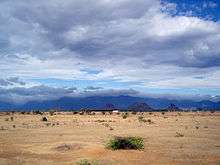Agasthyavanam Biological Park
Agasthyavanam Biological Park is a protected area in the Western Ghats, India. The park is located in Kuttichal panchayat, and lies between the Neyyar and Peppara Wildlife Sanctuaries. It covers an area of about 31 square kilometres.[1]
| Agasthyavanam Biological Park | |
|---|---|
| Location | |
History
After decades of environmental degradation, the Indian government formed a committee in 1992 to look into the possibility of a biological park in the region of Kottur in Kerala. In 1997, the Agasthyavanam Biological Park was formed. Located near the state’s capital city of Thiruvananthapuram (formerly Trivendrum), the park is named after the Agastimalai Agasthyakoodam mountain peak that rises up from the center of the park. The park was established as part of the Agasthyavanam Project, in order to conserve the flora and fauna of the region and ensure the recovery of the delicate ecological balance that was lost over the decades.[2]Conservatories have been planned for breeding and reintroducing rare and endangered endemic animals into the forest. Buses run regularly from Trivandrum to the park, although only 50 tourists are allowed inside the park every day. Trekking facilities are also available, with the pathway up to the Agasthyamalai peak often cited as the most sought-after pass.1.
Agasthyamalai Biosphere Reserve (100% centrally sponsored scheme)
Agasthyamalai Biosphere Reserve (ABR) was notified on 12. November 2001. under UNESCO’s Man and Biosphere Programme. The ABR falls exclusively in Kerala, covering an area of 1701 km2. The forest tracts of Neyyar, Peppara, Shendumey wildlife Sancturias and Achencoil, Thenmala, Konni, Punalur, Thiruvananthapuram Divisions, and Agasthyavanam Special Division is included in ABR.
For the coordination of the activities of various departments in the B.R. area and for ensuring the scientific management of the B.R., a local committee, and state-level Biosphere Management Committee were also constituted as per GOI guidelines.
- 1281 ha. of the area were evicted from Mathikettan Shola and declared as a National Park.
- Including Agasthyamala 1701 km2 area declared as Agasthyamala Biosphere Reserve.
The Agasthyavanam Project
In 1992, the Government of Kerala constituted a scientific committee to study the feasibility of setting up a Biological park in the highly degraded forest area of Kottoor at Kuttichal Panchayat. The committee suggested that the ultimate objective of the endeavor be to regenerate, conserve and propagate selected wild flora and fauna. The area earmarked had a negligible tree and animal population despite its abundant water resources. The soil was found to be fertile and the climate salubrious. The flora and fauna, which existed here previously, should have been the representatives of Western Ghats.
The Kottoor Reserve forests lie in the Paruthipalli range of the Trivandrum forest division. It lies on the western slopes of the Western Ghats, at the south-east corner in Nedumangad Taluk in Kuttichal Panchayat. It is contiguous with the Neyyar Wildlife Sanctuary in the southwest borders and the Peppara Wildlife Sanctuary in the northeast. The highly degraded nature of this area was the reason for not including it in any of the sanctuaries.
The Agasthyamala Biosphere Reserve is located in the southernmost end of the Western Ghats and incorporates peaks towering 1,868 m above sea level. It covers 3,500 km and encompasses tropical forest ecosystems that fall within the Tirunelvi and Kanyakumari districts of Tamil Nadu and the Thiruvananthapuram and Kollam districts of Kerala.
The total estimated area of the park is 23 km2. Of this, 17.5 km2 is to be converted to thick jungle, while the rest is for manipulative conservation programs. Conservatories will be established for a variety of plant species and for the reintroduction, production, breeding, and propagation of wild animals and birds.
In spite of the good rainfall received, the quick drainage of water from the area to the Arabian Sea leaves the place barren for around six months. Small check dams, if built, can retain water in small ponds and preserve the humidity and moisture, promoting vegetation growth in the dry season. Thus the Agasthyavanam Project, in short, aims at ecotourism, afforestation and conservation.
Objectives of the Project:
- Regeneration and eco-restoration of the degraded forest of Kottoor Reserve.
- Scientific conservation of the existing flora and fauna.
- To create maximum biodiversity by reintroducing the extinct endemic species.
- To achieve maximum, sustainable utilization of water and soil.
- To facilitate documentation of flora and fauna.
- To encourage research and eco-tourism.
Tourist Information
The administrative responsibility of this park lies with the Wildlife Warden, Trivandrum. The airport and railway station at Trivandrum are very close to the reserve. Bus routes extend to Bonakkadu near Vithura 35 km walk unavoidable to reach, and another bus route is Trivandrum-Kattakada - Kuttichal -Kotoor- Chonapara Tribal settlement. This is the easiest way to go by KSRTC Bus station. There are lodges and hotels in Kuttichal, 32 km from Trivandrum, and Kuttichal, 08 km from Neyyar Dam, 20 km from Ponmudi and 08 km from Agastya Vanam biological park, India's first biological park.
A maximum of 50 people per day is allowed into the park. Visitors are issued an entry pass from the Trivandrum Wildlife Division against payment of Rs 50. It is better to halt at Athiramal, as there is no accommodation near the park.
External links
| Wikimedia Commons has media related to Agasthyavanam Biological Park. |
References
- "Agasthyavanam Biological Park Range". Archived from the original on 4 March 2016. Retrieved 4 March 2013.
- "Agasthyavanam Biological Park". India.com. Retrieved 16 June 2020.
